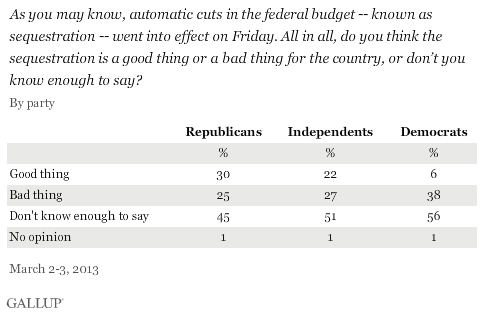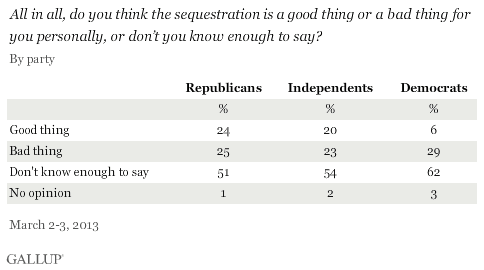PRINCETON, NJ -- In the initial days after the budget sequester went into effect, a majority (51%) of Americans say they don't know enough to judge whether the automatic cuts in the budget put in place last Friday are a good or a bad thing for the country. The remainder tilt toward negative evaluations of the sequestration's impact on the country, by 30% to 18%. Similarly, the majority of Americans don't yet have enough information to judge sequestration's impact on themselves personally, but among those who do, the tilt is negative, by 26% to 17%.
![As you may know, automatic cuts in the federal budget -- known as sequestration -- went into effect on Friday. All in all, do you think the sequestration is a good thing or a bad thing [for the country/for you personally], or don’t you know enough to say?](http://content.gallup.com/origin/gallupinc/GallupSpaces/Production/Cms/POLL/nz8cruxtg0mxbnzhnh6nrw.gif)
A Gallup survey conducted before sequestration went into effect Friday showed that Americans wanted Congress to pass legislation to avoid it, by 45% to 37%, and that the majority thought the cuts would harm the U.S. economy "this year" if they were enacted. The new questions, asked March 2-3, in the first days after the sequester went into effect, gave respondents the "or don't you know enough to say" option, which typically results in larger proportions of unsure responses than if that alternative is not made explicit. The views of those with an opinion continue to tilt negative, although now, the responses to the question with the new wording show that more say they will need to wait to assess whether the cuts are good or bad for the country or for themselves. Indeed, many experts on budgetary matters say it may take a while for the cuts' effects to become apparent as they begin to move through the system.
Democrats Most Likely to View Sequestration's Impact as Bad
Democrats are more likely than either independents or Republicans to have one-sided views on the sequestration's impact -- and these tilt significantly toward the negative. Six percent of Democrats say sequestration is a good thing for the country or for themselves personally, while 38% say it will be a bad thing for the country and 29% deem it bad for themselves personally.
Republicans by a narrow five-percentage-point margin say sequestration is a good thing for the country, while essentially breaking even in their views of its impact on them personally. Independents tilt slightly negative on both.


Republicans are slightly more likely to have an opinion about sequestration's impact than are independents or Democrats, but large percentages of all three partisan groups say they don't know enough to say at this early stage.
Bottom Line
Americans' attitudes are mixed just a day or two after the sequestration budget cuts took place. Slightly more than half say in essence that the jury is still out -- that they don't know enough about the impact of the cuts to judge whether it is good or bad for the country or for themselves. Still, those who do have an opinion tilt toward saying the cuts will be bad rather than good, in line with what Gallup found before the cuts took place.
Democrats with an opinion are the most likely to view the cuts as harmful -- by ratios of about 5 to 1 and 6 to 1, respectively, they say the cuts will have a negative impact on the country or on themselves. Republicans and independents have much more mixed views.
If nothing is done to change the course of the sequestration legislation going forward, the effects will almost certainly begin to be more evident to Americans -- through news reports or from firsthand experience. Gallup will continue to provide insights into the degree to which Americans' perceptions of the cuts may change in the weeks and months ahead.
Survey Methods
Results for this Gallup poll are based on telephone interviews conducted March 2-3, 2013, on the Gallup Daily tracking survey, with a random sample of 1,028 adults, aged 18 and older, living in all 50 U.S. states and the District of Columbia.
For results based on the total sample of national adults, one can say with 95% confidence that the margin of sampling error is ±4 percentage points.
Interviews are conducted with respondents on landline telephones and cellular phones, with interviews conducted in Spanish for respondents who are primarily Spanish-speaking. Each sample of national adults includes a minimum quota of 50% cellphone respondents and 50% landline respondents, with additional minimum quotas by region. Landline telephone numbers are chosen at random among listed telephone numbers. Cellphones numbers are selected using random digit dial methods. Landline respondents are chosen at random within each household on the basis of which member had the most recent birthday.
Samples are weighted to correct for unequal selection probability, nonresponse, and double coverage of landline and cell users in the two sampling frames. They are also weighted to match the national demographics of gender, age, race, Hispanic ethnicity, education, region, population density, and phone status (cellphone only/landline only/both, cellphone mostly, and having an unlisted landline number). Demographic weighting targets are based on the March 2012 Current Population Survey figures for the aged 18 and older U.S. population. Phone status targets are based on the July-December 2011 National Health Interview Survey. Population density targets are based on the 2010 census. All reported margins of sampling error include the computed design effects for weighting.
In addition to sampling error, question wording and practical difficulties in conducting surveys can introduce error or bias into the findings of public opinion polls.
View methodology, full question results, and trend data.
For more details on Gallup's polling methodology, visit www.gallup.com.